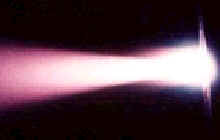Magnetoplasmadynamic thruster
|
|
Magneto-Plasmadynamic (MPD) thrusters are a form of electric Propulsion which use the Lorentz force (a force exerted on charged particles by magnetic and electrical fields in combination) to generate thrust. As with other electric propulsion variations, both specific impulse and thrust increase with power input.
There are two main types of MPD thrusters, applied-field and self-field. Applied-field thrusters have magnetic rings surrounding the exhaust chamber to produce the magnetic field, while self-field thrusters have a cathode extending through the middle of the chamber. Applied fields are necessary at lower power levels, where self-field configurations are too weak. Various propellants such as xenon, neon, argon, hydrazine, and lithium have been used, with lithium generally being the best performer.
| Contents |
Advantages
In theory, MPD thrusters could produce extremely high specific impulses (Isp) of up to and beyond 11,000 s (110 kNĚs/kg), triple the value of current xenon-based ion thrusters. But perhaps the most impressive characteristic of MPD technology is thrust levels of up to 200 newtons (N), by far the highest for any form of electric propulsion, and nearly as high as interplanetary chemical rockets. This would allow use of electric propulsion on missions which require quick delta-v maneuvers (and as such are currently limited to chemical rockets), while having many times greater fuel efficiency.
Problems with MPD
Self-field_MPD_thruster-CGI_illustration.jpeg
Research
The former Soviet Union researched MPD technology more deeply than the United States, successfully running a 500 kW MPD thruster in steady-state mode for 500 hours. Currently, MPD research is still being done by the Moscow Aviation Institute (MAI) for JPL, as well as multiple other universities and institutions throughout the world.

